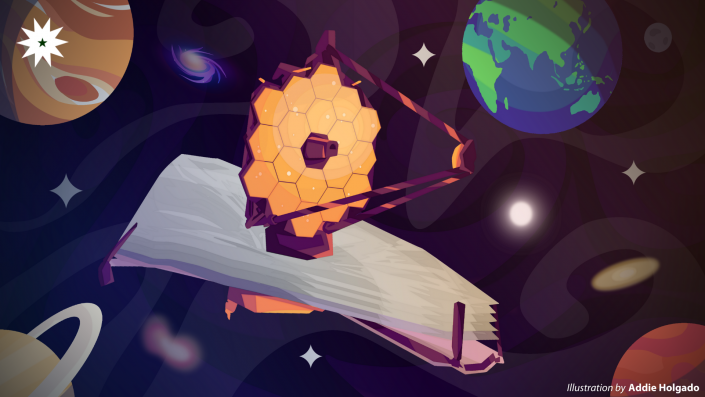In only a few weeks, our cosmic horizon will be extended farther out than ever before. On December 22, an Ariane 5 rocket is set to ferry the James Webb Space Telescope (JWST) into space and boost it on a 30-day journey toward Lagrange point 2 (L2), where the telescope will orbit for the duration of its 10-year mission.
Once deployed, the JWST will become the largest operational space telescope—a title it will take from the Hubble Space Telescope (HST). Its size will allow it to resolve the faintest and farthest objects in the cosmos, giving astronomers the ability to probe the early Universe, observe the evolution of galaxies and star systems, and analyze star systems across the galaxy.

Building JWST
Dr. Matt Greenhouse, the project scientist for the JWST science instrument payload, talks about the limitations NASA faced when building the telescope. “We needed a mirror that was bigger in diameter than the biggest rocket, so that was huge problem number one,” Greenhouse explains, adding, “Huge problem number two was that…we had to build an infrared telescope.”
Since nearly everything emits infrared light, however, the six-and-a-half-ton telescope has to be cooled to just 50 Kelvin (K)—27 K colder than even liquid nitrogen, which is used for cryogenic freezing. “Those were the two enormous problems which almost stopped the project…but we solved both of them,” he remarks.
In order to fit the JWST’s 6.5-meter (m) mirror into the Ariane 5’s 4.57-m payload fairing, NASA designed the telescope to have a segmented mirror architecture. “We built 18 mirror segments that are mechanized such that they can play together as if they were a single mirror,” Greenhouse notes. This way, the panels are initially folded shut and fan out into their full-size configuration once deployed.
The telescope’s mirror segments are also made from beryllium rather than glass, such as the HST’s mirror. Beryllium, while extremely expensive and hard to work with, is also very thermally conductive, which prevents thermal gradients from forming. The metal also has a high stiffness-to-weight ratio which is important since any additional weight is a premium when it comes to spaceflight.
To tackle the cooling issue, NASA employed a simple but extremely effective solution: a sunshade. Since the telescope orbits L2, a point of gravitational equilibrium between the Earth and the Sun, “all the sources of heat on the JWST—the sun, the earth, and the moon—are always in the same direction,” he illustrates. Thus, the telescope can passively cool in the darkness of its tennis court-size sunshade.
While the telescope’s L2 orbit has numerous benefits, it also brings some difficulties. Since L2 is four times farther from the Earth than the Moon, a servicing mission to perform repairs would be prohibitively difficult. Maintaining an L2 orbit also requires thrusters since L2 is inherently unstable. Greenhouse explains, “The propellant for those station-keeping thrusters [is] the expandable supply that will ultimately limit the duration of the JWST mission.”
Systems operational
Once the JWST is in orbit around L2, it will undergo six months of calibration and system checks before it starts regular operations. Among the telescope’s main objectives is to observe the eras of recombination—when the Universe first had light—and reionization, during which newly formed, energetic stars ionized the hydrogen in the early Universe.
The telescope is also set to study the birth of stars and galaxies, characterize exoplanetary systems and atmospheres, and, according to Greenhouse, “observe Mars and the outer planets of the solar system, and perhaps most importantly…observe the Kuiper belt objects or trans-Neptunian objects.”
Regarding who has access to telescope time, he answers, “Any institution worldwide…Once a year, there is a call for proposals that goes out to the professional astronomy professors worldwide…some are selected, then these projects are uploaded to the telescope.” Even astronomers whose proposals get rejected can still use the telescope as its data is made publicly available after a year, he mentions.
A long-awaited liftoff
To be launched from the Guiana Space Center, the JWST encountered multiple launch date postponements due to numerous redesigns and its elaborate construction.
On the topic of the delays and budget overruns, Greenhouse remarks, “There were roughly 10 technologies that had to be invented to make the JWST possible, and sometimes technology development takes longer than expected…But it’s all behind us now, it was successfully completed.” In the event that launch complications occur, Greenhouse assures that due to the L2 orbit being located relatively close to Earth, the telescope could be launched at any time.
In the past?
With a telescope as highly anticipated as the JWST, it is only natural that astronomers and the public alike wish to give it a name worthy of its promises. In 2015, however, the telescope’s legacy was embroiled in controversy when its namesake, former NASA administrator James Webb, was alleged to be complicit in the Lavender Scare, a mid-century movement that led to the removal of gay and lesbian employees from the US federal workforce.
These allegations resulted in a petition for the JWST to be renamed, with most of the signatures coming from professional astronomers and astronomy students. Due to the gravity of the case, an investigation by NASA’s notably arranged history team was launched. The team, however, was unable to uncover sufficient evidence which would warrant changing the name of the telescope. Greenhouse affirms, “It looks like the name will remain the same.”
Our Universe, unveiled
History is bound to be rewritten. Through the JWST’s mirrors, our Universe will be unveiled in all its infrared splendor, and we will see how the cosmos we live in has come to be. Once the telescope starts on its mission, yet-examined questions in astronomy and cosmology will finally be answered. In a sense, the technology, engineering, and people behind the JWST will bring the distant past into our present—and launch humanity into the future.
